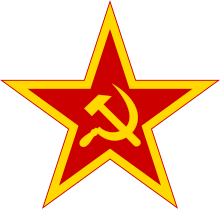Collective leadership
Collective leadership is a distribution of power within an organisational structure. It is considered an ideal form of ruling a communist party, both within and outside a socialist state.
Examples
China
Collective leadership in China is generally considered to have begun with Deng Xiaoping in the 1970s, who tried to encourage the Politburo Standing Committee to rule by consensus in order to prevent the authoritarianism of Maoist rule. Jiang Zemin formally established himself as the "first among equals". This era of collective leadership has been said to end with Xi Jinping, following the abolition of term limits in 2018 under his tenure.[1]
Currently, the central authority of the Chinese government is concentrated in the Politburo Standing Committee, which is composed of 7-members of the Communist Party of China and headed by the General Secretary of the Central Committee.[2]
Vietnam
In Vietnam, when the country was ruled by Lê Duẩn, collective leadership involved powers being distributed from the office of General Secretary of the Communist Party and shared with the Politburo Standing Committee while still retaining one ruler.
Nowadays, in Vietnam there is not one paramount leader, and power is shared by the party General Secretary, President and the Prime Minister along with collegial bodies such as the Politburo, Secretariat and the Central Committee.
Soviet Union
Collective leadership (Russian: коллективное руководство, kollektivnoye rukovodstvo) or Collectivity of leadership (Russian: коллективность руководства, kollektivnost rukovodstva), was considered an ideal form of governance in the Union of Soviet Socialist Republics (USSR). Its main task was to distribute powers and functions among the Politburo, the Central Committee, and the Council of Ministers to hinder any attempts to create a one-man dominance over the Soviet political system by a Soviet leader, such as that seen under Joseph Stalin's rule. On the national level, the heart of the collective leadership was officially the Central Committee of the Communist Party, but in practice, was the Politburo. Collective leadership is characterized by limiting the powers of the General Secretary and the Chairman of the Council of Ministers as related to other offices by enhancing the powers of collective bodies, such as the Politburo.
Lenin was, according to Soviet literature, the perfect example of a leader ruling in favour of the collective. Stalin also embodied this style of ruling, with most major policy decisions involving lengthy discussion and debate in the politburo and/or central commmittee; after his death in 1953, Nikita Khrushchev accused Stalin of one-man dominance, leading to controversy surrounding the period of his rule. At the 20th Party Congress, Stalin's reign was criticized by Khrushchev as a "personality cult". As Stalin's successor, Khrushchev supported the ideal of collective leadership but increasingly ruled in an autocratic fashion, his anti-Stalin accusations followed by much the same behaviour which led to accusations of hypocrisy. In 1964, Khrushchev was ousted and replaced by Leonid Brezhnev as First Secretary and by Alexei Kosygin as Premier. Collective leadership was strengthened during the Brezhnev years and the later reigns of Yuri Andropov and Konstantin Chernenko. Mikhail Gorbachev's reforms helped spawn factionalism within the Soviet leadership, and members of Gorbachev's faction openly disagreed with him on key issues. The factions usually disagreed on how little or how much reform was needed to rejuvenate the Soviet system.
Notes
- ↑ Holtz, Michael (28 February 2018). "Xi for life? China turns its back on collective leadership". Christian Science Monitor. Retrieved 23 June 2018.
- ↑ "New Politburo Standing Committee decided: Mingjing News" Archived 2013-01-15 at the Wayback Machine.. Want China Times. 18 October 2012. Retrieved 2 January 2013.
Sources
- Baylis, Thomas A. (1989). Governing by Committee: Collegial Leadership in Advanced Societies. State University of New York Press. ISBN 978-0-88706-944-4.
- Cocks, Paul; Daniels, Robert Vincent; Whittier Heer, Nancy (1976). The Dynamics of Soviet Politics. Harvard University Press. ISBN 978-0-674-21881-9.
- Christian, David (1997). Imperial and Soviet Russia: Power, Privilege, and the Challenge of Modernity. Palgrave Macmillan. ISBN 978-0-312-17352-4.
- Taras, Roy (1989). Leadership Change in Communist States. Routledge. ISBN 978-0-04-445277-5.
- Law, David A. (1975). Russian Civilization. Ardent Media. ISBN 978-0-8422-0529-0.
